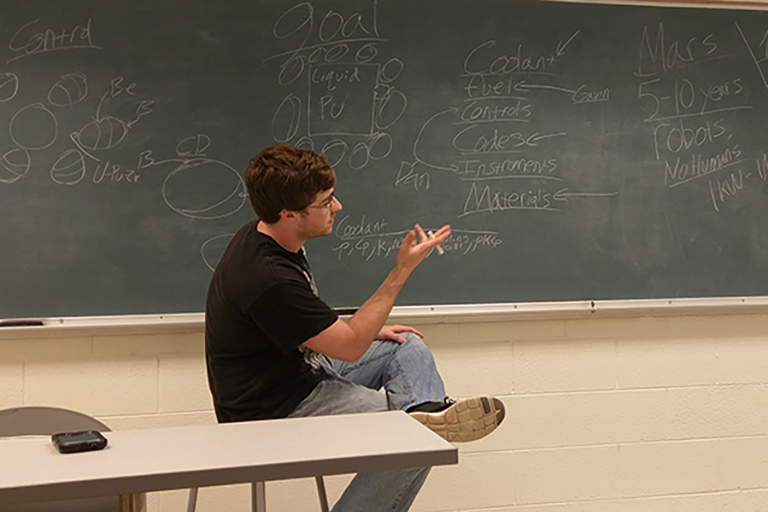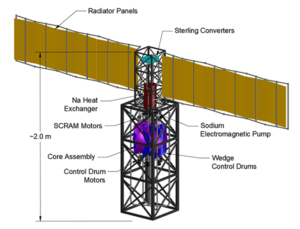
Senior Dan Floyd talks through challenges with his teammates.
A team of nuclear engineering students took up the senior design project challenge of providing power for extraterrestrial surface missions—namely, a trip to Mars.
The crew included Gavin Ridley, Dan Floyd, Walter Tebbs, and Patrick Tidwell, with mentoring by Adjunct Assistant Professor Thomas Harrison. They designed PULSR, the Plutonium Ultra-Light Space Reactor, to produce power for a 20-year mission.
“I think the group was, in general, inspired by the radical departure that space reactor concepts can take from terrestrial atomic power in favor of high-power densities and long operating lifetimes,” said Ridley. “This presents a very interesting technological challenge, since such power generation has to be delivered in a lightweight package.”
The cost of sending a kilogram of equipment to Mars can soar well into six digits, so a lighter design saves dollars.
—Gavin Ridley
They found that one of the biggest lessons of the project was in how nuanced computational fluid dynamics can be.
“Generating a good mesh, using the right turbulence models, and setting the right boundary conditions seem at times to be such mathematically difficult problems that it’s more of an art than anything,” said Ridley.
 The team chose to spice up the design by using excess weapons-grade plutonium as fuel. They chose this partly as a symbol of peace—repurposing the material for progress rather than destruction—and partly due to its extraordinary potential as space-reactor fuel. They packed it into a spherical container made of tantaloy, with sodium coolant flowing over it to remove heat.
The team chose to spice up the design by using excess weapons-grade plutonium as fuel. They chose this partly as a symbol of peace—repurposing the material for progress rather than destruction—and partly due to its extraordinary potential as space-reactor fuel. They packed it into a spherical container made of tantaloy, with sodium coolant flowing over it to remove heat.
“The biggest challenge was finding data to back up the fact that there are metals which are corrosion-resistant to liquid plutonium-based fuel,” said Ridley. “We would have not undertaken these design decisions if Los Alamos national lab had not explored liquid plutonium-based fuels as a fast reactor concept in the 1960s.”
Still, it was challenging to design a thermal-spectrum reactor which operates on nearly pure Pu-239 and maintains stability.
“We think the design is a success because our calculations show it will be stable and continuously make 20 kilowatts of power over a 20-year lifespan,” said Ridley. “Best of all, it will fit in a package weighing in around 60 kilograms.”